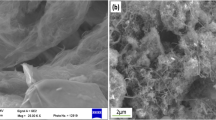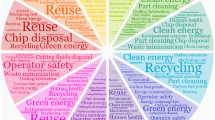Abstract
The roughness of thermal barrier coatings (TBCs) prepared on the surface of aero-engine turbine blades affects the lifetime of the coating and the life cycle and aerodynamic performance of the blades. To reduce the TBC surface roughness, this study proposes a robot polishing trajectory planning method that combines reverse engineering and finite element mesh technology. First, a 3D model of the blade was reconstructed in reverse engineering by using the fast surface modeling method. Then, a dense mesh with controlled spacing was obtained by mapping the finite element mesh arbitrary quadrilateral elements on the surface of the blade model. Finally, a robot polishing path of the blade was generated by sorting the index of mesh nodes. Using this approach, polishing experiments of aero-engine turbine blades were systematically carried out, and the coordinate system conversion method from the robot off-line programming simulation environment to the actual work station was used to map the robot trajectory. Meanwhile, the point cloud registration method was introduced to improve the system calibration accuracy. The experiments showed that the technical solution proposed in this paper could reduce the overall surface roughness of the thermal barrier coating from above Ra 8 μm to about Ra 0.5 μm, which contributes to the performance improvement for the TBCs of aero-engine blades.





























Similar content being viewed by others
References
S.H.Y. Najjar and A.I. Balawneh, Optimization of Gas Turbines for Sustainable Turbojet Propulsion, Propul. Power Res., 2015, 4(2), p 114–121.
J.H. Perepezko, The Hotter the Engine, the Better, Science, 2009, 326(5956), p 1068–1069.
M.D. Barringer, K.A. Thole and M.D. Polanka, Effects of Combustor Exit Profiles on Vane Aerodynamic Loading and Heat Transfer in a High Pressure Turbine, J. Turbomach., 2009, 131(2), p 021008.
J.S. Park, D.H. Lee, D. Rhee, S.H. Kang and H.H. Cho, Heat Transfer and Film Cooling Effectiveness on the Squealer Tip of a Turbine Blade, Energy, 2014, 72, p 331–343.
J.C. Han and M. Huh, Recent Studies in Turbine Blade Internal Cooling, Heat Transf. Res., 2010, 41(8), p 803–828.
K. Bochenek and M. Basista, Advances in Processing of NiAl Intermetallic Alloys and Composites for High Temperature Aerospace Applications, Prog. Aerosp. Sci., 2015, 79, p 136–146.
W. Beele, G. Marijnissen and A. van Lieshout, The Evolution of Thermal Barrier Coatings—Status and Upcoming Solutions for Today’s Key Issues, Surf. Coat. Technol., 1999, 120–121, p 61–67.
R.A. Miller, Current Status of Thermal Barrier Coatings—An Overview, Surf. Coat. Technol., 1987, 30(1), p 1–11.
G. Mauer, M.O. Jarligo, D.E. Mack and R. Vassen, Plasma-Sprayed Thermal Barrier Coatings: New Materials, Processing Issues, and Solutions, J. Therm. Spray Technol., 2013, 22(5), p 646–658.
S. Bose and J. Demasi-Marcin, Thermal Barrier Coating Experience in Gas Turbine Engines at Pratt and Whitney, J. Therm. Spray Technol., 1997, 6(1), p 99–104.
N.P. Padture, M. Gell and E.H. Jordan, Materials Science—Thermal Barrier Coatings for Gas-Turbine Engine Applications, Science, 2002, 296(5566), p 280–284.
T. Sadowski and P. Golewski, Multidisciplinary Analysis of the Operational Temperature Increase of Turbine Blades in Combustion Engines by Application of the Ceramic Thermal Barrier Coatings (TBC), Comput. Mater. Sci., 2011, 50(4), p 1326–1335.
R.A. Miller, Thermal Barrier Coatings for Aircraft Engines: History and Directions, J. Therm. Spray Technol., 1997, 6(1), p 35–42.
R. Vassen, M.O. Jarligo, T. Steinke, D.E. Mack and D. Stover, Overview on Advanced Thermal Barrier Coatings, Surf. Coat. Technol., 2010, 205(4), p 938–942.
A. Vardelle, C. Moreau, J. Akedo, H. Ashrafizadeh, C.C. Berndt, J.O. Berghaus, M. Boulos, J. Brogan, A.C. Bourtsalas, A. Dolatabadi et al., The 2016 Thermal Spray Roadmap, J. Therm. Spray Technol., 2016, 25(8), p 1376–1440.
Q.M. Yu, Q. He and F.L. Ning, Influence of Interface Morphology on Erosion Failure of Thermal Barrier Coatings, Ceram. Int., 2018, 44(17), p 21349–21357.
J.P. Bons, A review of Surface Roughness Effects in Gas Turbines, J. Turbomach., 2010, 132(2), p 021004.
S. Sampath, U. Schulz, M.O. Jarligo and S. Kuroda, Processing Science of Advanced Thermal-Barrier Systems, Mrs Bull., 2012, 37(10), p 903–910.
Y.Z. Fu, X.P. Wang, H. Gao, H.B. Wei and S.C. Li, Blade Surface Uniformity of Blisk Finished by Abrasive Flow Machining, Int. J. Adv. Manuf. Technol., 2016, 84(5–8), p 1725–1735.
S.J. Zhang, Y.P. Zhou, H.J. Zhang, Z.W. Xiong and S. To, Advances in Ultra-Precision Machining of Micro-Structured Functional Surfaces and Their Typical Applications, Int. J. Mach. Tool Manuf., 2019, 142, p 16–41.
Y.X. Song, W. Liang and Y. Yang, A Method for Grinding Removal Control of a Robot Belt Grinding System, J. Intell. Manuf., 2012, 23(5), p 1903–1913.
W. Wang and C. Yun, A Path Planning Method for Robotic Belt Surface Grinding, Chin. J. Aeronaut., 2011, 24(4), p 520–526.
J.A. Dieste, A. Fernández, D. Roba, B. Gonzalvo and P. Lucas, Automatic Grinding and Polishing Using Spherical Robot, Procedia Eng., 2013, 63, p 938–946.
F. Rafieian, B. Hazel and Z. Liu, Regenerative Instability Of Impact-Cutting Material Removal in the Grinding Process Performed by a Flexible Robot Arm, Procedia CIRP, 2014, 14, p 406–411.
P. Zhou, X. Zhao, B. Tao and H. Ding, Time-Varying Isobaric Surface Reconstruction and Path Planning for Robotic Grinding of Weak-Stiffness Workpieces, Robot Cim Int. Manuf., 2020, 64, 101945.
Y. Lee, Non-isoparametric Tool Path Planning by Machining Strip Evaluation for 5-Axis Sculptured Surface Machining, Comput. Aided Des., 1998, 30(7), p 559–570.
S. Ding, M.A. Mannan, A.N. Poo, D. Yang and Z. Han, The Implementation of Adaptive Isoplanar Tool Path Generation for the Machining of Free-Form Surfaces, Int. J. Adv. Manuf. Technol., 2005, 26(7–8), p 852–860.
Z.H. Xie, F.G. Xie, X.J. Liu and J.S. Wang, Global G(3) Continuity Toolpath Smoothing for a 5-DoF Machining Robot with Parallel Kinematics, Robot Cim-Int. Manuf., 2021, 67, p 102018.
D.Y. Chang and Y.M. Chang, A Freeform Surface Modelling System Based on Laser Scan Data for Reverse Engineering, Int. J. Adv. Manuf. Technol., 2002, 20(1), p 9–19.
K.H. Lee, H. Woo and T. Suk, Data Reduction Methods for Reverse Engineering, Int. J. Adv. Manuf. Technol., 2001, 17(10), p 735–743.
G.Q. Jin, W.D. Li and L. Gao, An adaptive Process Planning Approach of Rapid Prototyping and Manufacturing, Robot Cim-Int. Manuf., 2013, 29(1), p 23–38.
H.B. Jung and K. Kim, A New Parameterisation Method for NURBS Surface Interpolation, Int. J. Adv. Manuf. Technol., 2000, 16(11), p 784–790.
M. Aigner, L. Gonzalez-Vega, B. Juttler, M. L. Sampoli, Computing Isophotes on Free-Form Surfaces Based on Support Function Approximation, in 2009-01-01; York, United Kingdom (Springer, 2009), pp. 1–18
V. Weiss, L. Andor, G. Renner and T. Varady, Advanced Surface Fitting Techniques, Comput. Aided Geom. D, 2002, 19(1), p 19–42.
R. Sevilla, S. Fernandez-Mendez and A. Huerta, 3D NURBS-Enhanced Finite Element Method (NEFEM), Int. J. Numer. Methods Eng., 2011, 88(2), p 103–125.
Z.H. Cai, H. Liang, S.H. Quan, S.H. Deng, C.N. Zeng and F. Zhang, Computer-Aided Robot Trajectory Auto-Generation Strategy in Thermal Spraying, J. Therm. Spray Technol., 2015, 24(7), p 1235–1245.
E. Carrera, Theories and Finite Elements for Multilayered, Anisotropic, Composite Plates and Shells, Archiv. Comput. Method E, 2002, 9(2), p 87–140.
M. Fredriksson and N.S. Ottosen, Fast and Accurate 4-Node Quadrilateral, Int. J. Numer. Methods Eng., 2004, 61(11), p 1809–1834.
P. Besl and H.D. Mckay, A Method for Registration of 3-D Shapes, IEEE Trans. Pattern Anal. Mach. Intell., 1992, 14, p 239–256.
Author information
Authors and Affiliations
Corresponding author
Additional information
Publisher's Note
Springer Nature remains neutral with regard to jurisdictional claims in published maps and institutional affiliations.
Rights and permissions
About this article
Cite this article
Yang, F., Cai, Z., Chen, Y. et al. A Robotic Polishing Trajectory Planning Method Combining Reverse Engineering and Finite Element Mesh Technology for Aero-Engine Turbine Blade TBCs. J Therm Spray Tech 31, 2050–2067 (2022). https://doi.org/10.1007/s11666-022-01434-9
Received:
Revised:
Accepted:
Published:
Issue Date:
DOI: https://doi.org/10.1007/s11666-022-01434-9




